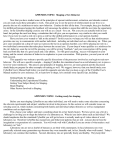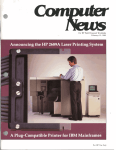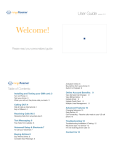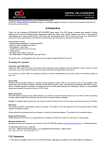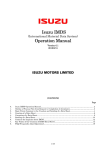Download First Four Chapters Free
Transcript
THE COMPLETE GUIDE TO CANADA’S GENERAL MOBILE RADIO SERVICE ____________________________________________ HOW TO GET THE MOST OUT OF OUR NATION’S LICENSE-FREE, FEE-FREE UHF TWO-WAY RADIO SERVICE Phillip J. Boucher THE COMPLETE GUIDE TO CANADA’S GENERAL MOBILE RADIO SERVICE ____________________________________________ HOW TO GET THE MOST OUT OF OUR NATION’S LICENSE-FREE, FEE-FREE UHF TWO-WAY RADIO SERVICE Phillip J. Boucher FIRST EDITION – 2010 COPYRIGHT © 2010 by Phillip J. Boucher REPRODUCTION OF THE CONTENTS OF THIS BOOK IN ANY MANNER IS STRICTLY PROHIBITED WITHOUT THE EXPRESS WRITTEN CONSENT OF THE PUBLISHER/AUTHOR AND A FEE MAY BE PAYABLE FOR SUCH USE. SHORT QUOTES OF FIFTY WORDS OR LESS MAY BE USED WITHOUT PRIOR PERMISSION FOR REVIEW PURPOSES PROVIDED PROPER SOURCING IS INCLUDED. ALTHOUGH EVERY EFFORT HAS BEEN MADE TO ENSURE THE ACCURACY OF THE INFORMATION HEREIN, THE PUBLISHER/AUTHOR, AND ANY OF HIS REPRESENTATIVES, LEGAL OR OTHERWISE, ASSUME NO LIABILITY OR RESPONSIBILITY FOR ANY ERRORS OR OMISSIONS, NOR FOR ANY INJURY HOWSOEVER CAUSED, BE IT PHYSICAL, FINANCIAL, LEGAL, OR OTHERWISE, INCURRED IN THE USE OF THIS BOOK. READER AGREES TO ASSUME ALL RISKS AND UNDERSTANDS THAT THIS BOOK COMES WITHOUT ANY EXPRESS WARRANTY AND FOR INFORMATIONAL PURPOSES ONLY. THE READER UNDERSTANDS THAT THE USE OF ANY RADIO COMMUNICATIONS DEVICE IN CANADA IS SUBJECT TO ALL RULES, REGULATIONS, AND PROVISIONS AS SET OUT BY INDUSTRY CANADA, THE RADIO ACT, AND OTHER APPLICABLE LAWS WHICH MAY BE CHANGED OR UPDATED AT ANY TIME, AND AGREES TO ABIDE BY THE AFOREMENTIONED IN THE OPERATION OF THEIR FRS/GMRS EQUIPMENT. THIS BOOK IS INTENDED SOLELY FOR THOSE READERS OPERATING FRS/GMRS RADIO EQUIPMENT IN CANADA AND IS NOT INTENDED FOR ANY OTHER USE. ISBN 978-1-895391-21-3 Published by the author. Cover photo courtesy of Cobra Electronics. All other equipment photos, unless specified, courtesy of Cobra Electronics. All other photos by the author. Information is current as of date of publication. Designed and Created by the Author in Canada The Complete Guide to Canada’s General Mobile Radio Service / Boucher TABLE OF CONTENTS INTRODUCTION 6 WHAT IS GMRS? 8 WHAT GMRS IS NOT 12 WHAT ABOUT THOSE BUSINESS-EXCLUSIVE RADIOS? 13 THE MANY USES OF GMRS 14 AMATEUR RADIO OPERATORS 14 AT HOME AND OUT ON THE TOWN 15 BACKUP COMMUNICATIONS SYSTEM 19 BUSINESS/CORPORATE 20 EMERGENCY PREPAREDNESS 23 EVENT COORDINATION 23 FARMING 24 FUNERAL HOMES 24 GOVERNMENT/MUNICIPAL 24 HOSPITALS / OLD AGE HOMES 27 HOTELS / MOTEL / CONFERENCE CENTRES 27 MINING INDUSTRY 27 MOVIE THEATRES / ENTERTAINMENT VENUES 28 NORTHERN COMMUNICATIONS 28 PARANORMAL INVESTIGATIONS 28 REMOTE TEACHING 29 RESTAURANTS 29 RETAIL 29 1 The Complete Guide to Canada’s General Mobile Radio Service / Boucher SCHOOLS 30 SEARCH AND RESCUE / EMERGENCY RESPONSE 31 TRUCKING 32 ZOOS 33 WHERE GMRS SHOULD NOT BE USED 34 AIRPLANES AND TERMINALS 34 BLASTING SITES 34 CASINOS 35 GAS STATIONS 35 HOSPITALS 35 HOW TO SELECT THE PROPER GMRS RADIO 37 ADVERTISED DISTANCE VS ACTUAL TRANSMISSION RANGE 38 STANDARD FEATURES 39 BELLS AND WHISTLES 43 PRICE CONSIDERATIONS 45 ACCESSORIES 45 HOW TO OPERATE A GMRS RADIO 48 MICROPHONE 48 PTT 48 RADIO 48 SAFETY 49 TALKING 49 USER MANUAL 49 ON-AIR BEHAVIOUR: GMRS RADIO ETIQUETTE 50 2 The Complete Guide to Canada’s General Mobile Radio Service / Boucher ALL UNITS SHOULD IDENTIFY 50 KEEP TRANSMISSIONS SHORT 50 NO ILLEGAL USE OR ACTIVITIES 51 CODES 55 GENERIC 10 CODE 55 COLOUR CODE 56 Q CODES 57 DEVELOPING YOUR OWN CODES 57 PHONETIC ALPHABET AND NUMBER SYSTEM 58 PHONETIC ALPHABET 58 PHONETIC NUMBERS 58 UNIT DESIGNATORS 59 SETTING UP A GMRS SYSTEM FOR YOUR ORGANIZATION OR GROUP 60 GMRS EQUIPMENT ACQUISITION 60 TRAINING 61 GMRS AS AN EMERGENCY BACKUP SYSTEM 61 GMRS RADIO POLICY AND PROCEDURE MANUAL 62 MAINTENANCE 65 PROPER CARE OF YOUR GMRS EQUIPMENT 65 TROUBLESHOOTING 68 WILL NOT TURN ON, DEAD, BATTERIES DIE OUT FAST 68 WILL NOT TRANSMIT A SIGNAL 69 WILL NOT RECEIVE A SIGNAL 69 3 The Complete Guide to Canada’s General Mobile Radio Service / Boucher NO TRANSMIT AUDIO 69 NO RECEIVE AUDIO 69 PREPARE THE TOE-TAG 69 EMERGENCY COMMUNICATIONS 71 PROPOSED GMRS UNIVERSAL EMERGENCY CHANNEL 72 EMERGENCY COMMUNICATIONS IN TODAY’S POLITICAL ENVIRONMENT 73 HEARING AN EMERGENCY CALL 74 MAKING AN EMERGENCY CALL 75 EMERGENCY USE OF GMRS DEMONSTRATED 76 GMRS AS A STEPPING STONE TO RADIO COMMUNICATIONS EDUCATION 77 AMATEUR RADIO 77 COMMERCIAL, GOVERNMENT, PUBLIC UTILITY, PUBLIC SERVICE RADIO 77 SCANNER MONITORING 79 SHORTWAVE RADIO 79 FINAL THOUGHTS 80 READER FEEDBACK 81 GMRS GLOSSARY 82 GOVERNMENT REFERENCES 95 INDUSTRY CANADA 95 INTERNET RESOURCES 96 WEBSITES 96 4 The Complete Guide to Canada’s General Mobile Radio Service / Boucher 5 NEWSGROUPS 97 GMRS RADIO REVIEWS 98 LIST OF MANUFACTURES CURRENTLY SELLING GMRS EQUIPMENT IN CANADA 105 CONSULTANTS IN RADIO COMMUNICATIONS THAT SPECIALIZE IN GMRS APPLICATIONS IN CANADA 106 PHILLIP J. BOUCHER 106 APPENDIX 107 GMRS FREQUENCY CHART 107 CTCSS RADIO TONE CHART 107 NEIGHBOURHOOD COMMUNITY RADIO 108 INDEX 109 ABOUT THE AUTHOR 111 The Complete Guide to Canada’s General Mobile Radio Service / Boucher 6 INTRODUCTION In today’s society we have come to rely on an extremely wide variety of wireless communications devices to help us keep in touch with our friends, family, co-workers, managers and supervisors, and staff. Such equipment may consist of cellular telephones and similar devices, laptops, pagers, or two-way radios. Whether for business or pleasure, we Canadians spend, both on an individual and corporate level, a large amount of money each month and year on wireless devices and services to communicate with people from one end of the country to the other, all around the city, or just across the street. We talk about the most mundane and unimportant things anyone could think of and we talk about matters that are literally of life and death. None of this talking occurs free of charge, and we depend on expensive communication infrastructures to ensure that our wireless communications are transmitted and received efficiently and effectively with a minimum amount of interruption or outage. Sometimes our messages need to be conveyed immediately within a very short distance and the use of cellular phone, pager, or commercial radio gear and services can seem quite prohibitive when the distances just aren't that great to justify the costs incurred. So with this is mind, would you and your family, your business and your employees, or your group and its members like to keep in wireless contact with each other without the use of pagers or cellular phones, and without renting any two-way radio equipment? Would you like to do this without having to pay for airtime, licenses, administrative and access fees, or subscribing to a service? Would you like to save money by not having to pay for any monthly fees or time up front? Well, you can do all that with just the one-time purchase of inexpensive handheld two-way radio devices that give you commercial-quality radio communications at a cost far below commercial prices. Approved on April 1, 2000, the Canadian Government authorized FRS, the Family Radio Service (officially known as Family Radio Devices), as a means of providing short-range UHF-FM radio communications to the general public using low power, unlicensed, handheld two-way radios. On September 7, 2004, GMRS, or the General Mobile Radio Service, became an addition and extension of FRS, and they both now effectively operate as one combined service. For the purposes of this book, all references to GMRS include FRS unless otherwise noted. GMRS allows users to keep in touch with each other up to a distance of approximately eight to ten kilometres during most types of recreational or business activities. The service uses FM (Frequency Modulation) in the UHF (Ultra High Frequency) band for good clear signals and was initially intended for communications amongst a group of people during recreational activities, though business use of the service has become more common. Some GMRS radios are equipped The Complete Guide to Canada’s General Mobile Radio Service / Boucher 7 with features that can enhance the abilities of the service and equipment, such as FM stereo receivers and the Global Positioning System (GPS). GMRS authorization resulted from Industry Canada's solicitation from the public and the radio communications industry on the viability of implementing such a system here in Canada that has been in use in the United States for many years. In the States, FRS and GMRS are extremely popular services, and manufacturers of both FRS and GMRS radios have not only seen constant sales increases each year, but the demand for more sophisticated radios has driven them to provide even more features than existed on models manufactured only a year or two earlier. FRS and GMRS are established and popular services in the United States and the same thing will happen with our combined service here in Canada. The consensus is that Canadian GMRS will gain in popularity over the years, providing better and cheaper radios with more and more features. As a long-term user of two-way radio equipment in both personal and professional applications, I see such a great opportunity for GMRS to connect family, friends, and co-workers in a way that public two-way radio has not been able to do in the past. This book is intended to help any current or potential GMRS user get the most from their equipment and the service, from the couple who just want to keep in touch while out at the mall, to the small business that needs its employees to be able to communicate within a building or on a job site, and almost everyone in between and beyond. In fact, anyone who reads this book should be able to realize a new use for GMRS for their own purposes. It only takes a bit of imagination to discover the possibilities of recreational or business use of this service and to see a significant monetary savings compared to other wireless services. Use this book as both an introduction and reference guide for all your GMRS radio communications needs. The Complete Guide to Canada’s General Mobile Radio Service / Boucher 8 WHAT IS GMRS? FRS stands for Family Radio Service and initially was a two-way radio communications service provided to the Canadian public by Industry Canada. The service used small, handheld, two-way radios operating on fourteen frequencies in the 462 MHz (megahertz, or million cycles per second) and 467 MHz bands, seven channels from each band. These low-power devices transmitted a signal of one half-watt of output power. GMRS stands for General Mobile Radio Service. In the United States, GMRS is a licensed service with radios transmitting from two to five watts of power. Here in Canada, GMRS is a license-free service and is limited to two watts of output power, four times as much as FRS. It uses additional frequencies in the 462 MHz range. Everything else about GMRS is the same as FRS, and almost all of the radios you will find today that are sold in Canada combine both FRS and GMRS frequencies into one dual-band unit, essentially making both FRS and GMRS into one service. There are no licenses needed, and no examinations or other requirements are necessary to purchase and operate these radios. There are no fees or monthly bills to pay to use this service, no forms to fill out, and no credit checks or pre-paid cards to deal with. The only cost is the price of the radios and batteries, if the batteries are not included or the radios do not come with rechargeable battery packs. GMRS uses FM (Frequency Modulation) to carry your voice on the radio signal. FM is a cleaner mode of transmission, giving a better quality of audio to the signal. The UHF-FM bands of 462/467 MHz have certain characteristics that are both extremely welcome and somewhat unwanted. UHF (Ultra High Frequency) at this range has a wavelength (the actual length of one cycle of the radio wave) of about two feet. A quarter of this wavelength is about six inches, which is usually the length of the wire used as the antenna. This means that a rather small antenna can be used on the radio. UHF signals are better suited for use in areas that have much material in and around them as they can penetrate trees, buildings, and other structures quite well. Therefore, UHF is well suited for use in an urban environment though the signals travel a shorter distance than the lower frequencies on VHF (Very High Frequencies from 136 MHz to 174 MHz). With UHF, your transmission range in and around trees and buildings will diminish with the increasing amount of material between you and the people you are talking to, yet the efficiency and quality of the signal will be much better than the same power signal from a VHF radio. As a general comparison, if we transmit with the same amount of output power from both a VHF handheld radio and a UHF handheld radio, the VHF signal would travel farther, but would be more susceptible to reflection and absorption by tress, buildings, and other materials that would degrade the signal. The UHF signal will not travel as far, but would not be affected as much by The Complete Guide to Canada’s General Mobile Radio Service / Boucher 9 the same materials. The signal may not appear as strong to the receiving radio, but it will have a better quality to it. For most short-range radio communications, UHF is the best all around choice. A GMRS UHF radio signal at two watts of output power can have a range of about eight to ten kilometres over water. That range is reduced when used in a rural and urban setting. On average, the indoor range can cover approximately two hundred thousand square feet, or about twenty floors of a building, and very easily the average warehouse or job site. When used in a city setting, you can usually get reliable communications from two to eight city blocks depending on terrain and building architecture. Keep in mind that one of the major factors for the authorization of this service is short-range communications, so almost all the radios you will find are handheld ones (although some manufactures do or intend to sell base and mobile units that have built in antennas. However, these units are not popular in Canada and are hard to find.) You will not likely find a community of users on any of the GMRS channels because of the nature of UHF signals and the design and intent of the radios, though as time marches on and GMRS becomes more popular, you will notice more people on the channels with some of them possibly being very close to you. There may eventually even be some GMRS neighbourhood groups that get together in your area for a scheduled chitchat. However, the chances of just going on your radio and saying you are listening and having people come back and talk to you are extremely remote. You will not be able to do that as you can on CB. GMRS is not a community recreational radio service or a hobby radio service at all. It simply does not have the ability to be used as such even with two watts of transmitting power. If you intend to use GMRS for business purposes, you must weigh the convenience and low cost of the service with the required needs of your business. For job sites, inter-office communications, or communications between floors in a building or throughout a warehouse, the distances covered would be quite suitable for GMRS and these are just some of the uses being advertised for the more expensive business-exclusive radios (which I'll talk about shortly.) For small town or neighbourhood delivery services, or other types of service providers, the larger your area of coverage, the less area you can operate effectively in with GMRS radios, so you may need a licensed service or the use of a wide-area communications service provider, such as two-way radio repeaters or PTT (Push-To-Talk) cellular. If you are unsure of whether GMRS may be suitable for your organization, you should talk to a radio communications consultant who specializes in the GMRS service. They will ask you questions about your organization and exactly how you intend to use two-way radios in your day-to-day activities. The consultant will let you know if GMRS is viable for your needs. If it is, they will help you decide what type of radios to get or what features you may need. If not, they The Complete Guide to Canada’s General Mobile Radio Service / Boucher 10 can suggest the proper radio system to suit your requirements. Further discussion of the business use of the GMRS service will be covered in a later chapter. GMRS is definitely something that has been needed here in Canada for a very long time. In the late eighties and early nineties, pagers were the popular fad. If you had a pager, you were in the groove, part of the crowd, hip and cool. Then cellular phones became more affordable and more popular, with the pay-as-you-talk services exploding in even greater demand as the millennium approached. Today, we send text messages and surf the Internet, take pictures and video, listen to a million hours of music files, watch feature-length films, and store all of our appointments on our wireless phones. In addition, many people on cell phones don’t even use them to talk long distance. Many wireless phone calls are between people who are only few blocks away from each other. Teens use cellular phones before, during, and after school to talk to friends who may be down in the study hall or a few houses away. But even the shortest of distance of a cellular or pager call costs money whether on a prepaid or monthly billing system. GMRS, free from these fees, can supplement or replace a lot of pager or wireless phone use. Don’t forget about the cost of short-range radio communications used by government and business. They operate on commercial or government frequencies, paying fees for licensing both the units and the frequencies. In many cases GMRS can substitute for this equipment, bringing the cost of using two-way radios down significantly and allowing money to be allocated for other purposes. And for government radio equipment, which we all pay for in taxes, GMRS could mean that our tax dollars could be used more effectively elsewhere. It is obvious that we Canadians enjoy talking to each other. When Alexander Graham Bell invented the telephone (a Canadian invention) he never knew that the world would embrace the capability of keeping in touch with such a fanatic fervour. Nowadays, just by looking at the number of people on their wireless phones and Bluetooth headsets as they go about their daily activities, you can see that we have a desire, or really an obsession, to be connected with each other. Even the Internet has exploded with millions of websites, chat rooms, blogs and discussion forums, instant messaging, and internet telephone services popping up every day. GMRS is not an absolute substitute for a pager or a cell phone by any means. But the inexpensive radios and totally cost-free use means that for most short-range communications, the cost of some pager and cell phone use can be reduced if not eliminated. Our communications instinct can still be satiated. It means that everyone can keep in contact and stay safe, and you and I can rely on GMRS radios to help us keep in touch with our family and friends, our business associates and co-workers, and each other. The Complete Guide to Canada’s General Mobile Radio Service / Boucher 11 The author engaged in a conversation with his wife while trimming the yard. If only one thing can be said about what GMRS is, it is that GMRS will take our desire to communicate with others to the next level of our existence. In fact, I predict that GMRS radios or a derivative thereof will, within ten to fifteen years, become so common, that one out of every three Canadians will carry some type of GMRS or similar type radio on their person at all times! The Complete Guide to Canada’s General Mobile Radio Service / Boucher 12 WHAT GMRS IS NOT GMRS is not a hobby radio service like Amateur Radio or Citizen’s Band Radio. If you listen to CB or Ham radio, you will find that people who have never met and never heard of each other before, become friends and can talk for hours. CB and Amateur Radio are hobby radio services. They allow people the ability to connect with one another for recreational communications. GMRS is intended to provide short-range communications for people who already know each other or, at least, are gathered on a channel for a specific common purpose. Random contacts are rare on GMRS. It just isn’t “hobby radio”. GMRS is not a private or personal system by any means. There are only twenty-two channels that can be used, with thirty-eight CTCSS sub-audible squelch tones, and even more DCS squelch codes per channel available. (CTCSS stands for Continuous Tone-coded Squelch System and DCS is Digital Coded Squelch. A receiving radio enabled with a tone or code won’t open up the audio circuit to the speaker unless it receives the same tone or code along with the transmitted signal.). However, even if there are two groups of users on one channel with each using a different CTCSS or DCS tone, and there may appear to be two “sub-channels”, the truth is that if the groups are close enough there may be quite a bit of interference when one person using one tone and another person using another tone transmit simultaneously. CTCSS and DCS squelch “privacy” tones or codes, as the industry calls them, are not private at all and there are no such things as “sub-channels” as the industry likes to infer. Anyone listening to your signal can hear everything being said if their CTCSS or DCS tone is set to the same one you are using, or they are not using any receiving tone setting at all. When you set your “privacy tone” to the same one used by the people you wish to communicate with, your radio and theirs will be silent unless a signal with the same tone is received. Tones are simply used to block out any unwanted received signals from other users who may be in range. Tones do not block or prevent other users from hearing you nor prevent any interference that might occur. GMRS has great potential but also has many limitations. It is not a solution to all of our communications woes. But a good understanding of GMRS’s advantages and disadvantages means you will be able to use the GMRS service to suit your purposes. The Complete Guide to Canada’s General Mobile Radio Service / Boucher 13 WHAT ABOUT THOSE BUSINESS-EXCLUSIVE RADIOS? Due to the transition of many Canadian businesses from business-band radios to GMRS, the push now by manufactures, distributors, and service providers is to market radios labelled as “Business-Exclusive” or “Business-Exclusive Frequencies” as the preferred choice for commercial and corporate two-way radio communications. Manufacturers, distributors, and twoway radio service providers seem to be aware that GMRS radios can and do provide the same range and quality signal as their more expensive “designated” equipment for far less of a cost to the business user. These radios are simply the older “business band” radios repackaged and remarketed to compete against GMRS. These radios still use the standard assigned business-band frequencies. These commercial two-watt UHF handheld radios using “business-exclusive” frequencies start at around one hundred fifty dollars per unit to purchase. A pair of two watt GMRS radios can retail anywhere from thirty-five dollars to one hundred thirty dollars, depending on features and accessories (with GMRS radios incorporating GPS receivers costing much more.) With businessexclusive radios you may have to pay airtime, monthly or yearly fees, radio and channel licensing, or other costs which can become quite expensive. Depending on your area or local radio shop, you may not even be able to purchase these commercial radios. You may have to rent or lease them, which will still cost you much more money than the one-time purchase of GMRS equipment. Most of the features on GMRS and business radios are the same including scanning, calling, and signalling features. The only advantage the two watt UHF commercial radios have over two watt GMRS radios is the fact that the general public does not have ready access to these business frequencies as they do for GMRS frequencies, meaning that the probability for interference from other users, including children, is far less. However, if you are in a crowded urban area, those “business-exclusive” frequencies may not be as “exclusive” as you thought they might be. There could very well be many other users licensed on the same frequencies as you in your area. In this case, you get no advantage using these radios over GMRS, and in fact, GMRS may even be less crowded in your area than you think. Unless you purchase, rent, or lease the five-watt UHF business radios for greater transmission power and range, there is no advantage of these two watt radios over two watt GMRS radios. They will both do the same job. So why pay more money for “business-exclusive” when you don't have to?

















